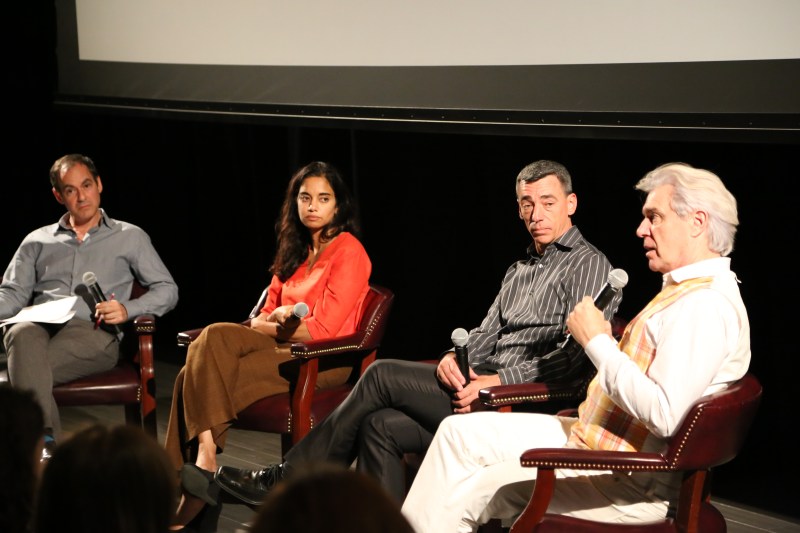David Byrne and Mala Gaonkar want you to learn without knowing that you’re learning. If there’s one thing that they made clear over the course of their 1.5-hour discussion on Wednesday at the McMurtry Building with Stanford professors Anthony Wagner (psychology and neuroscience) and Charles Kronengold (music), it was that principle of subtle teaching. The discussion of their new piece of experiential theater, “The Institute Presents: NEUROSOCIETY,” was animated by that inclination, made most overt by Byrne’s declaration that helping audiences learn about themselves through the show was a “strong desire, but a secret desire.”
Byrne, most widely known as the bandleader and lead singer for American New Wave group Talking Heads, and Gaonkar, a tech investor, are perhaps not the most conventional pair of artistic collaborators, especially for an alternative theater experience based on neuroscience experiments — they admitted during the discussion that they were “rank amateurs” at any sort of theater. Yet their conversation made clear that they share both a deep curiosity about the workings of the human mind and an attention to the details of the human experience.
At times Byrne and Gaonkar seemed inexperienced or unsure about the precise details of the show, but their fundamental principles remained consistent. The two showrunners demonstrated a clear focus on how audiences would react, understand and learn from the performance, even in its smallest details. At one point, they discussed the decor in the building lobby, which features photographs of more serious neuroscience experiments in order to build expectations for the performance. More importantly, they discussed changing a part of the performance about unconscious bias from a simulation of shooting possible assailant based on race to one less racially charged.
The original versions of the show apparently demonstrated the unconscious bias held by all people by putting the participants into a situation where they would have to quickly decide whether to shoot approaching figures of various races, both unarmed and armed. Yet in the final version, Byrne and Gaonkar have replaced it with an exercise in choosing presidential winners based on appearance. While such a move could be seen as milquetoast avoidance of controversy, Byrne explained it quite differently, saying that the change was made so that the exhibit won’t immediately “lose the argument” about unconscious bias by directly attacking participants.
Byrne and Gaonkar’s talk about designing experiences to subtly guide audiences into learning about themselves was interesting on its own. Considering that design motivation in light of Byrne’s prior work with Talking Heads adds an even more fascinating dimension to his statements. Unlike many of their contemporaries in the new wave and punk scenes of the late ’70s and ’80s, Talking Heads was rarely overtly political or moralistic — its music was too disjointed, too rhythmic and twitchy to preach to you the way The Clash or Elvis Costello could. Yet Talking Heads could hardly be described as a band focused only on danceable rhythms and chart success. At its best, especially on the three albums that it released from 1979 to 1983, the band was able to use their music organically to spur on intellectual growth, without falling into the trap of simply telling you what to believe. On those three albums — “Fear of Music,” “Remain In Light” and “Speaking In Tongues” — Talking Heads achieved a fusion of inventive, eclectic compositions and Byrne’s ironic, free-associative lyrics, all creating some of the most thought-provoking music of any time period.
It’s always easier to teach directly, through music or through any form of performance. Experiential learning is inherently messier — when you don’t tell your audience how to feel about something, they’ll end up feeling every way possible. While that openness can lead to fascinating results, it can also be frustrating for creators. In recent years, a number of messy, sprawling concept albums, most notably Kendrick Lamar’s “To Pimp a Butterfly,” have ended with songs that attempt to sum up the album’s “point,” narrowing down an expansive work to a more digestible message. It’s an understandable urge, but including such an ending limits the possibilities for further intellectual exploration. In any art form, be it new wave music or experimental theater, sometimes the most interesting results come from leaving the work ambiguous.
Contact Jacob Kuppermann at jkupperm ‘at’ stanford.edu
